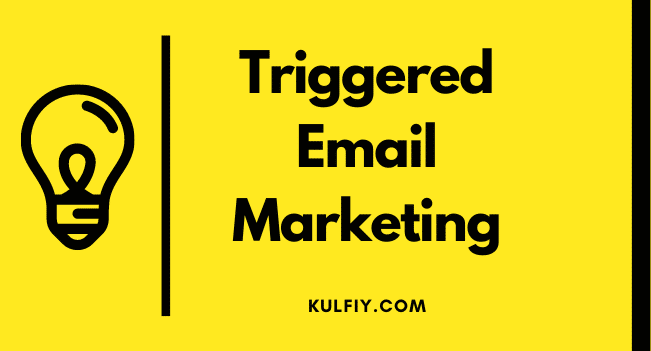Table of Contents
If you have ever received an email about items you forgot in an online shopping cart and ended up completing the purchase from it, you were targeted by a triggered email.
Triggered emails can also be used in some specific scenarios of automated email marketing, such as:
- Price drop reminder for a wishlist item
- Subscription renewal reminder
- Customer onboarding series
and many others!
But there’s a lot more to triggered email marketing than just being able to send emails automatically triggered by customer actions.
How does Triggered Email Marketing work?
Triggered emails are a great application of the email automation systems, besides the emails sent for lead nurturing.
To start marketing with triggered emails, the following list of broad steps can be followed:
- Set up a trigger (based on user action or behaviour change)
- Write your email content to send in response to the trigger (only once)
- Personalize your email content
- Measure how your triggered emails perform and optimize them if required
Benefits of Triggered Email Marketing
Triggered emails are inherently more relatable for receivers. The combination of on-time and personalized messaging provides a whole host of benefits.
This section provides a detailed look on benefits of using triggered emails.
1. Higher email open rates and click-through rates
Because the trigger is a customer’s action, triggered emails are customer-centric. It becomes a natural part of the customer’s journey as it is that much more relatable.
A direct result is higher open-rate to emails and better click-through rates. Thus, triggered emails help alleviate major concerns of marketers with automated email marketing.
SmartInsights reports that triggered and autoresponder emails have open rates anywhere between 50% and 100% more than passive newsletter emails. Click-through rates are also 2 to 3 times more.
Readers can also follow these steps below to improve these metrics:
- Shorten your subject lines. A study by SendGrid found that 3-word subject lines get the highest engagement
- Segment your email lists and personalize the marketing communication.
- Include the principles of scarcity and urgency in the subject line.
2. Higher conversion rates
Triggered emails are highly effective even when the receiver has clicked through the email and is on the landing page. That is because it has high relevance by design and not just content. Customers are well aware of what they are receiving and are equally willing to act on it if the triggered email is written carefully.
As conversion rates increase, marketers who use automated triggers for sending emails will see the following benefits:
- Profits lost through customer actions such as cart abandonment can be recovered through reminder emails.
- Triggered emails such as order confirmation also perfectly suited to push cross-selling and upselling opportunities for the customer, leading to higher revenue.
3. Better quality leads and higher brand loyalty
The overall quality of leads collected from the email list also improves with triggered emails because marketers are communicating with a qualified subscriber.
A welcome email sequence sent on a trigger of registration brings immediate engagement and sets the customer up for brand loyalty in the long-term.
Triggered emails are useful across the complete marketing lifecycle – from cold lead stage to recurring customer stage, for both B2B and B2C companies. This could also lead to a potentially shorter sales lifecycle.
4. Higher relevance in marketing communication
Because the marketing messages are based on the customer’s actions, it is highly likely to be aligned with their purchase cycle. Therefore, the relevance of triggered marketing messages is consistently high.
However, to get the best out of triggered emails, take care of the following factors to deliver precisely tailored triggered marketing messages:
- The trigger must be timed appropriately around the timing of the user action
- The triggered email can be personalized based on the user’s
Location
Demographics
Historical behaviour
CRM data
5. Increased customer retention
Why is retaining customers more important?
Because acquiring new customers is costlier than retaining existing ones.
When triggered emails are used after a lead’s conversion into a customer, it naturally compounds their trust in the brand.
Here are some examples that demonstrate how to use triggered emails for existing customers:
- Feedback email
- Appointment reminder
- Subscription renewal reminder
- Notification for “back-in-stock” products
- Promotions on special dates
- Re-engagement reminder when absence is noticed
Prompt follow-ups, personalized communication, and instant responsiveness all make triggered emails highly conducive for increased customer loyalty and retention.
Triggered emails are more profitable than lead nurturing emails
To make email marketing automation “more personal” and “less robotic”, marketers must have a defined personalization strategy. Triggered emails are a core component of this strategy.
With these emails, there is a far more direct and easily traceable effect on the company’s profits.
Even then, triggered emails must not be used on an ad-hoc basis. There needs to be a triggered marketing strategy that addresses the entire customer journey
